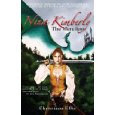
In
The Fall Of Ossard,
Colin Taber tells the story of Juvela Van Leuwin, granddaughter of a woman burnt at the stake for being a witch, by the Inquisitor Anton, member of the Church of Baimiopia’s Expeditia Puritanica. The burning was 20 twenty years ago and it was a milestone in Ossard’s history. Since then, Ossard has grown wealthy by its merchant princes. However now the city is troubled by another problem: Child abductions... The children simply vanish without a trace and without any witnesses... And it’s just the beginning...
Don't Judge A Book By It But...The first time I looked at the cover of The Fall Of Ossard, it gave me the impression that something dark and sinister was happening in this city. With a close look, one can see a burning tower. It reminds me of one of my favorite movies: The Crow.
About The BookI didn’t know Colin Taber before I decided to read The Fall Of Ossard. Now I’m glad that I gave it a try. The three adjectives on its cover capture the spirit of the book pretty well:
“Bold... Innovative... Brave...” The book is easy to read and captivating. The very beginning of the story, the burning of Juvela’s grandmother, promises a fast-paced book. And it keeps its word. With the introduction of Juvela, the story slows down but to gather momentum with each turning page.
Colin Taber’s style in his book reminded me of Patrick Rothfuss’ The Name Of The Wind, partly because the story was told in a first-person narrative mode. And the fact that Ossard is the main setting of the story and the world’s connection with its deities reminded me of Brendon Sanderson’s Elantris.
In The Fall Of Ossard, the author paints the picture of a world where the boundary between humanity and divinity is very thin and flexible. It is a world where gods can choose to answer the prayers with their blessings. It is a world where gods can be mean and vicious; they can have their own agenda and use their followers in a multitude ways. This book is a window opened to a world forged by the goddess Life and her husband Death. Yet now they’re waging a divine war, a war that promises doom for all.
The magic system that the author uses has a satisfying complexity. Even though we don’t explicitly get explained all the nitty-gritty details of spellcasting, we know that there are three different branches of magic that exist according to the power source of the caster: Mind (forbidden Sisterhood), Soul (priesthoods of the faiths) and Heart (Cabals of Mages). I’m guessing that we will discover more about magic in the following books.
One of the aspects of the book that I loved is the existence of the world’s mythology. The reader is introduced to some of the deities along the way. However the mention of a few other names, such as the Gorgoyle God of Gorloth promises more to come. Furthermore, there are some places mentioned that aren’t part of the story yet. For example, I wonder if we’ll ever know more about Bar-Mor, the mountain city of the giants.
If you’re a fan of maps in fantasy books, you’ll be satisfied to know that Colin Taber did a good job with the maps too. They include Ossard and the world around the city.
All in all, it's an amazing book. Colin Taber raises the bar very high in his debut novel, The Fall Of Ossard, which is the first of a trilogy. The second book promises a lot to come in many aspects. It will probably be published towards the end of the year. The author said that the remaining books were pretty much complete, so hopefully, there shouldn’t be any delays. I, for one, am looking forward to reading them. I can’t wait to hear the rest of the story...
(9/10)
 Subterranean Press are giving away Kage Baker's novelette called Speed, Speed the Cable (PDF file). It's a 24-page short novel and I really like the way that it's presented. I think the background image and the font are spot on for the genre.
Subterranean Press are giving away Kage Baker's novelette called Speed, Speed the Cable (PDF file). It's a 24-page short novel and I really like the way that it's presented. I think the background image and the font are spot on for the genre.











